Chapter 23.100
GENERAL DEFINITIONS
Sections:
23.100.020 General definitions.
23.100.010 Applicability.
The purpose of this chapter is to provide all general definitions of the terms and phrases used in this title that are technical or specialized in an effort to ensure provision in interpretation of the Zoning Code. Where any definition in this chapter may conflict with definitions in other titles of the Elk Grove Municipal Code, their definitions shall prevail for the purposes of this title. If a word is not defined in this chapter, or in other provisions of the Elk Grove Municipal Code, the most common dictionary definition is presumed to be correct. Definitions are organized alphabetically. [Ord. 8-2011 §41, eff. 6-24-2011]
23.100.020 General definitions.
A. “A” Definitions.
1. “Accessory dwelling unit” means an attached or detached residential dwelling unit, including a manufactured home or an efficiency unit, that provides complete independent living facilities for one (1) or more persons and is located on a lot with a proposed or existing primary residence. An accessory dwelling unit includes permanent provisions for living, sleeping, eating, cooking (kitchen, as defined in this chapter), and sanitation on the same lot as the single-family or multifamily dwelling is or will be situated. This definition includes so-called “granny flats.” This definition is consistent with the allowed use description titled “Dwelling, Accessory Unit.”
2. “Accessory structure” means a detached structure or building which is subordinate to, and the use of which is subordinate to, and whose use is customarily incidental to, that of the main building, structure, or use on the same or attached/adjacent lot. There are five (5) kinds of accessory structures as follows:
a. “Accessory building” means a detached structure ten (10 ft2) square feet in size or greater. Such structures are broken down into one (1) of the following three (3) categories:
i. Fully Enclosed. Structures that are enclosed with walls for at least fifty (50%) percent of the perimeter of the building. These include but are not limited to garages, greenhouses, poolhouses, sunrooms, workshops, storage sheds, barns, windmills, water towers, and other agricultural outbuildings;
ii. Limited/No Enclosure. Structures that are substantially open on all sides (less than fifty (50%) percent of the perimeter is enclosed), including:
– With solid roofs. These include but are not limited to carports, solid roofed patio covers and gazebos, and lean-tos and similar agricultural outbuildings with solid roof construction; and
– With substantially open roofs. These include trellis patio covers, arbors, pergolas, and similar structures constructed with a lattice-like roof structure. For purposes of this definition “substantially open” shall mean a minimum of fifty (50%) percent of the covered area is open to light and air.
b. “Landscape feature” means a detached decorative structure that is placed outside of any other structure. Such features are sometimes used in conjunction with plant materials for aesthetic enhancement. This definition includes trellises and vertical lattice structures less than ten (10 ft2) square feet in size, statues, fountains/water features, and similar features.
c. “Pool/spa,” as defined in the Uniform Building Code, is any structure intended for swimming or recreational bathing that contains water over eighteen (18") inches deep. This includes in-ground, aboveground, and on-ground swimming pools, hot tubs, and spas. Also includes incidental equipment and housing (e.g., pumps, heating equipment, etc.).
d. “Deck” means an exterior floor supported by posts, piers, or other independent supports. As an accessory structure, a deck is not supported by an adjacent structure.
e. “Play equipment” means any structure used for recreational purposes including play structures, jungle gyms, and swings, as defined in the California Building Code.
3. “Affordable rent” means monthly housing expenses, including a reasonable allowance for utilities (thirty (30%) percent of gross monthly income), for rental target units reserved for very low or low income households, not exceeding the following calculations: (a) “very low income” means fifty (50%) percent of the area median income for Sacramento County, adjusted for household size, multiplied by thirty (30%) percent, and (b) “low income” means sixty (60%) percent of the area median income for Sacramento County, adjusted for household size, multiplied by thirty (30%) percent, and divided by twelve (12).
4. “Abandoned sign” means any sign which is located on a premises that has been vacated for a period of more than one hundred eighty (180) days.
5. “Adult arcade” means any commercial establishment to which the public is permitted or invited wherein coin-operated, slug-operated, or for any form of consideration, electronically, electrically, or mechanically controlled still or motion picture machines, projectors, video or laser disc players, computer, or other image-producing devices are maintained to show images to four (4) or fewer persons per machine at any one (1) time, and where, as a regular and substantial course of conduct, the images so displayed are distinguished or characterized by an emphasis upon the depiction, description, showing, or simulation of specified sexual activities or specified anatomical areas. The phrase “regular and substantial course of conduct” shall be construed with reference to all relevant factors, including but not limited to the following:
a. The proportion of the business’ displays that are distinguished or characterized by an emphasis upon the depiction, description, showing, or simulation of specified sexual activities or specified anatomical areas.
b. The proportion of the business’ revenue that is attributable to displays that are distinguished or characterized by an emphasis upon the depiction, description, showing, or simulation of specified sexual activities or specified anatomical areas.
6. “Adult bookstore” (including “adult novelty store” or “adult video store”) means a commercial establishment which, as a regular and substantial course of conduct, offers for sale or rental for any form of consideration any one (1) or more of the following:
a. Books, magazines, periodicals or other printed matter, or photographs, films, motion pictures, video cassettes or video reproductions, any material in digital format (including, but not limited to, compact disc (CD) or digital video disc (DVD)), slides, or other visual representations which are distinguished or characterized by an emphasis upon the depiction, description, showing, or simulation of specified sexual activities or specified anatomical areas; or
b. Instruments, devices, or paraphernalia, except for clothing, which are designed for use in connection with specified sexual activities.
c. The phrase “regular and substantial course of conduct” shall be construed with reference to all relevant factors, including but not limited to the following:
i. The business devotes more than twenty-five (25%) percent of its retail inventory (not measured by the number of items but rather by the cost to the business owner of the inventory) to merchandise distinguished or characterized by an emphasis upon specified sexual activities or specified anatomical areas.
ii. The business devotes more than twenty-five (25%) percent of the retail floor area to merchandise that is distinguished or characterized by an emphasis upon specified sexual activities or specified anatomical areas.
iii. The retail value of merchandise that is distinguished or characterized by an emphasis upon specified sexual activities or specified anatomical areas exceeds twenty-five (25%) percent of the total retail value of inventory offered in each of the following categories: (A) books, (B) magazines, (C) video tapes or any material in digital format (including, but not limited to, compact disc (CD) or digital video disc (DVD)), for sale or rental, (D) novelties and devices, and (E) on-premises viewing of images, films, and/or videos.
iv. Gross revenue derived from merchandise in any category set forth in subsection (3)(c) of this definition exceeds twenty-five (25%) percent of the total gross revenue for the category.
v. There is a rebuttable presumption that a business constitutes an adult bookstore, adult novelty store or adult video store where the business (A) offers or advertises merchandise that is distinguished or characterized by an emphasis upon specified sexual activities or specified anatomical areas as set forth in subsection (c)(iii) of this definition and (B) fails to make revenue and inventory-related business records available to the City upon twenty-four (24) hours’ advance notice.
7. “Adult cabaret” means a nightclub, bar, restaurant, or similar commercial establishment which, as a regular and substantial course of conduct, features:
a. Persons who appear in a state of nudity or semi-nude condition; or
b. Live performances which are distinguished or characterized by an emphasis upon the exposure of specified anatomical areas or by specified sexual activities; or
c. Films, motion pictures, video cassettes, any material in digital format (including, but not limited to, compact disc (CD) or digital video disc (DVD)), slides or other photographic reproductions which are distinguished or characterized by an emphasis upon the depiction, description, showing, or simulation of specified sexual activities or specified anatomical areas;
d. The phrase “regular and substantial course of conduct” shall be construed with reference to all relevant factors, including but not limited to the following:
i. The proportion of the business’ performances or services that is distinguished or characterized by an emphasis upon the depiction, description, showing, or simulation of specified sexual activities or specified anatomical areas.
ii. The proportion of the business’ revenue that is attributable to performances or services that are distinguished or characterized by an emphasis upon the depiction, description, showing, or simulation of specified sexual activities or specified anatomical areas.
8. “Adult motel” (including “adult hotel”) means a hotel, motel or similar commercial establishment which offers accommodations to the public for any form of consideration; provides patrons with closed-circuit television transmissions, films, motion pictures, video cassettes, any materials in digital format (including, but not limited to, compact disc (CD) or digital video disk (DVD)), slides, or other photographic reproductions which, as a regular and substantial course of conduct, are distinguished or characterized by an emphasis upon the depiction, description, showing, or simulation of specified sexual activities or specified anatomical areas; and has any of the following characteristics:
a. A sign visible from the public right-of-way which advertises the availability of the above-described photographic reproductions; or
b. Offers a sleeping room for rent for a period of time that is less than ten (10) hours; or
c. Allows a tenant or occupant of a sleeping room to subrent the room for a period of time that is less than ten (10) hours.
9. “Adult motion picture theater” means a commercial establishment where, for any form of consideration, films, motion pictures, video cassettes, any materials in digital format (including, but not limited to, compact disc (CD) or digital video disk (DVD)), slides, or similar photographic reproductions are regularly shown which are distinguished or characterized by an emphasis upon the depiction or description of specified sexual activities or specified anatomical areas, for observation by five (5) or more patrons at any one time.
a. The phrase “regularly shown” shall be construed with reference to all relevant factors, including but not limited to the following:
i. The proportion of the theater’s photographic reproductions that are distinguished or characterized by an emphasis upon the depiction, description, showing, or simulation of specified sexual activities or specified anatomical areas.
ii. The number of photographic reproductions shown at the theater each month that are distinguished or characterized by an emphasis upon depiction, description, showing, or simulation of specified sexual activities or specified anatomical areas.
iii. The proportion of the business’ revenue that is attributable to entertainment that is distinguished or characterized by an emphasis upon the display or depiction of specified sexual activities or specified anatomical areas.
10. “Adult theater” means a theater, concert hall, auditorium, or similar commercial establishment which as a regular and substantial course of conduct features persons who appear in a state of nudity or semi-nude condition and/or features live performances which are distinguished or characterized by an emphasis upon the exposure of specified anatomical areas or by specified sexual activities.
a. The phrase “regular and substantial course of conduct” shall be construed with reference to all relevant factors, including but not limited to the following:
i. The proportion of the business’ performances or services that are distinguished or characterized by an emphasis upon the depiction, description, showing, or simulation of specified sexual activities or specified anatomical areas.
ii. The proportion of the business’ revenue that is attributable to entertainment that is distinguished or characterized by an emphasis upon the depiction, description, showing, or simulation of specified sexual activities or specified anatomical areas.
11. “Adult-oriented businesses” means any of the following commercial establishments where patrons are permitted or invited: an adult arcade, adult bookstore, adult novelty store, adult video store, adult cabaret, adult motel, adult motion picture theater, adult theater, nude model studio, or sexual encounter center.
12. “Affordable sales price” means a sales price at which lower or very low income households can qualify for the purchase of target units, calculated on the basis of underwriting standards of mortgage financing available for the development.
13. “Ambient noise” means the total of all noise in the environment minus the sound from a source of interest (background noise of an existing condition).
14. “Animated sign” means any sign which uses mechanical or electrical movement or change of lighting, either natural or artificial, to depict action or to create visual motion or the appearance therof.
15. “Antenna, amateur radio” means any antenna which is used for the purpose of transmitting and receiving radio signals in conjunction with an amateur radio station licensed by the Federal Communications Commission.
16. “Antenna, building-mounted” means any antenna directly attached or affixed to a building, tank, tower, or other structure. Building-mounted antennas are identified in two (2) distinct categories herein as follows:
a. “Wall-mounted” means attached or affixed to the elevation of the structure.
b. “Roof-mounted” means attached or affixed to the rooftop or top of the structure.
17. “Antenna, directional” (also known as a “panel antenna”) means an antenna that transmits and/or receives radio frequency signals in a directional pattern of less than three hundred sixty (360) degrees.
18. “Antenna, ground-mounted” means any antenna with its base (either single or multiple posts) placed directly on the ground or a mast twelve (12' 0") feet or less in height and six (6") inches in diameter.
19. “Antenna, parabolic” (also known as “satellite dish antenna”) means any device incorporating a reflective surface that is solid, open mesh, or bar configured that is shallow-dish-, cone-, horn-, bowl- or cornucopia-shaped and is used to transmit and/or receive electromagnetic or radio frequency communication/signals in a specific directional pattern from orbiting satellites or ground transmitters. This definition is meant to include what are commonly referred to as television receive only (TVRO) and satellite microwave antennas.
20. “Antenna” means any system of wires, poles, rods, reflecting discs, or similar devices used for the transmission or reception of electromagnetic waves when such system is either external to or attached to the exterior of a structure, or is portable or movable. Antennas shall include devices having active elements extending in any direction, and directional beam-type arrays having elements carried by and disposed from a generally horizontal boom that may be mounted upon and rotated through a vertical mast or tower interconnecting the boom and antenna support, all of which elements are deemed to be a part of the antenna.
21. “Area (of a sign)” means the measurable surface area of a sign, calculated as described in EGMC Section 23.62.120, General development, maintenance, and removal, and Figure 23.62-2.
22. “Awning” means any structure made of a flexible fabric or similar material covering a metal frame attached to a building, whether or not the same is so erected as to permit its being raised to a position flat against the building when not in use.
B. “B” Definitions.
1. “Banner” means any sign of lightweight fabric or similar material that is mounted to a pole or a building at one (1) or more edges. Flags shall not be considered banners (see definition of flag).
2. “Billboard” means a sign which meets any one (1) or more of the following criteria:
a. A permanent structure sign which is used for the display of off-site commercial messages;
b. A permanent structure sign which constitutes a principal, separate or secondary use, as opposed to an accessory use, of the parcel on which it is located;
c. An outdoor sign used as advertising for hire, e.g., on which display space is made available to parties other than the owner or operator of the sign or occupant of the parcel (not including those who rent space from the sign owner, when such space is on the same parcel or is the same development as the sign), in exchange for a rent, fee or other consideration; or
d. An off-site outdoor advertising sign on which space is leased or rented.
3. “Blade/bracket sign” means a small, pedestrian-oriented sign that projects perpendicular from a structure (bracket sign) or is hung beneath a canopy (blade sign; may also be referred to as an “under-canopy sign”).
4. “Buildable area” means the area of a lot that is not the required yard area.
5. “Building” means any structure having a roof, columns, walls, and a foundation.
6. “Building frontage, primary” means the building frontage that faces the street. In cases where a building has more than one (1) street frontage, the longest of the street frontages shall be considered the primary building frontage. In cases where a business has no building frontage facing a street, the building frontage with the primary business entrance shall be considered the primary building frontage (see Figure 23.100-1).
Figure 23.100-1
Building Frontage vs. Primary Building Frontage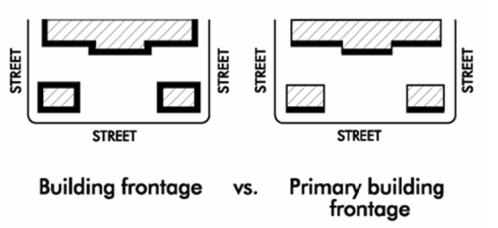
7. “Building sign” means a sign placed on a wall, awning, canopy, parapet, or a projecting sign.
8. “Business center district sign” means a sign identifying commercial establishments, uses, activities, or features within a business center as described in EGMC Section 23.42.080 (Business center district sign overlay zone (BCS)).
C. “C” Definitions.
1. “Canopy sign” means any sign that is part of or attached to an awning, canopy, or other material, or structural protective cover over a door, entrance, window, or outdoor service area.
2. “Changeable copy sign” means a sign or portion of a sign with characters, letters, or illustrations that can be changed or rearranged without altering the face or the surface of the sign. A sign on which the message changes more than once per day shall be considered an animated sign and not a changeable copy sign for purposes of this chapter.
3. “Child care facility” means a child day care facility other than a family day care home, including, but not limited to, infant centers, preschools, extended day care facilities, and school age child care centers.
4. “City property” means land or other property in which the City of Elk Grove holds a present right of possession and control, plus all public rights-of-way, plus public parks, regardless of ownership. Schools, even if publicly owned or operated, are not within this definition.
5. “City” means the City of Elk Grove, California.
6. “Clear-vision triangle” means the visibility control area as set forth in the City of Elk Grove Improvement Standards and Standard Drawings for sight distance at intersections and driveways.
7. “Cluster” or “clustering” means a site planning technique in which buildings and structures are concentrated in specific areas on a lot or development site to allow for the preservation of features and/or structures with environmental, scenic, historical, cultural, or other significance on the remaining land, and/or for the remaining land to be used for open space and recreation.
8. “Clustered development” means a land development project in which the clustering of buildings and other structures is used as a site planning technique.
9. “Co-location” means the locating of two (2) or more wireless communications facilities on a single wireless communication tower or base station.
10. “Commercial mascot” means a human or live animal used as a commercial advertising or signaling device. Sometimes called “sign twirlers” or “sign clowns.”
11. “Commercial message” means any sign wording, logo, or other representation that names or advertises a business, product, service, or other commercial activity.
12. “Commercial vehicle” means a motor vehicle of a type maintained for the transportation of persons for hire, compensation, or profit or designed, used, or maintained primarily for the transportation of property.
13. “Community noise equivalent level (CNEL)” means a twenty-four (24) hour energy equivalent level derived from a variety of single-noise events, with weighting factors of five (5) and ten (10) dBA applied to the evening (7:00 p.m. to 10:00 p.m.) and nighttime (10:00 p.m. to 7:00 a.m.) periods to allow for greater sensitivity to noise during these hours.
14. “Confined feeding area” shall mean any livestock feeding, handling, or holding operation or feed yard where animals are concentrated in an area:
a. Which is not normally used for pasture or for growing crops and in which animal wastes may accumulate; and
b. Where the space per animal is less than six hundred (600 ft2) square feet.
15. “Construction sign” means a temporary sign located on a site where physical construction is occurring or is scheduled to begin in the near future.
16. “Cottage food operation” means a cottage food operation as defined in the California Health and Safety Code.
17. “Custom home” means a home whose floor plan is only used once in a subdivision.
D. “D” Definitions.
1. “dB” means decibel, a unit used to express the relative intensity of a sound. Every increase of ten (10) dBA doubles the perceived loudness though the noise is actually ten (10) times more intense.
2. “dBA” means the “A-weighted” scale for measuring sound in decibels; adjusts the effects of low and high frequencies in order to simulate human hearing.
3. “Density bonus housing agreement” means a legally binding agreement between a developer and the City of Elk Grove to ensure that the requirements of this title are satisfied.
4. “Density bonus units” means those residential units granted pursuant to the provisions of this title, which exceed the otherwise maximum residential density for the development site.
5. “Density bonus” means a density increase of at least twenty (20%) percent, unless a lesser percentage is elected by the applicant, over the otherwise maximum allowable residential density.
6. “Designated approving authority” means the official or body of the City’s Planning Agency (e.g., City Council, Planning Commission, Zoning Administrator, Development Services Director), as defined in EGMC Section 23.10.020, who has the designated authority to grant or approve a planning permit, entitlement, or legislative action.
7. “Development agreement” refers to agreements entered into between developers and the City pursuant to Section 65864 et seq. of the Government Code as those sections exist or are hereafter amended or renumbered.
8. “Direct broadcast satellite service (DBS)” means a system in which signals are transmitted directly from a satellite to a small home receiving dish.
9. “Direct distribution” means, in the context of home occupations, the sale of goods from a home with delivery completed by third-party delivery services (e.g., FedEx, UPS, USPS), including but not limited to Internet sales.
10. “Directional sign, on-site” means a sign located on the same property as an establishment, primarily providing direction to guide vehicles and pedestrians to businesses, including but not limited to those signs identifying parking area and circulation patterns.
11. “Director” means the City’s Development Services Director or any other person authorized by the City Council to enforce and interpret this title.
12. “Directory sign” means a pedestrian-oriented sign that identifies or lists the names and locations of tenants at a multi-tenant site.
13. “Distinguished or characterized by an emphasis upon” means the dominant or essential theme of the object described by such phrase. For instance, when the phrase refers to films “which are distinguished or characterized by an emphasis upon the depiction or description of specified sexual activities or specified anatomical areas,” the films so described are those whose dominant or predominant character and theme are the depiction, description, showing, or simulation of the enumerated sexual activities or anatomical areas.
14. “Domestic violence shelter” means any emergency or transitional housing shelter operated with the primary purpose of sheltering victims of domestic violence and their children whose location is considered to be secured and confidential.
15. “Domestic violence victim” means any person who has been victimized by an imbalance of power in an intimate relationship where power and control have been used to force and/or coerce a partner through the use of emotional, psychological, physical and/or sexual abuse, or through stalking, to do something they do not wish to do or to stop them from doing something they wish to do.
E. “E” Definitions.
1. “Efficiency unit” means a dwelling unit that meets all of the following conditions: 1) The unit shall have a living room of not less than two hundred twenty (220 ft2) square feet of floor area. An additional one hundred (100 ft2) square feet of floor area shall be provided for each occupant of such unit in excess of two. 2) The unit shall be provided with a separate closet. 3) The unit shall be provided with a kitchen sink, cooking appliance and refrigeration facilities, each having a clear working space of not less than thirty (30”) inches in front. Light and ventilation conforming to this code shall be provided. 4) The unit shall be provided with a separate bathroom containing a water closet, lavatory and bathtub or shower.
2. “Electric vehicle (EV)” means an automotive-type vehicle for on-road use, such as passenger automobiles, buses, trucks, vans, neighborhood electric vehicles, electric motorcycles, and the like, primarily powered by an electric motor that draws current from a rechargeable storage battery, fuel cell, photovoltaic array, or other source of electric current. Plug-in hybrid electric vehicles (PHEV) are considered electric vehicles.
3. “Electric vehicle capable space (EV capable)” means a vehicle parking space with electrical panel space and load capacity to support a branch circuit and necessary raceways, both underground and/or surface mounted, to support EV charging.
4. “Electric vehicle ready (EV ready)” means a vehicle parking space which is provided with a branch circuit with a minimum of forty (40) ampere; any necessary raceways, both underground and/or surface mounted; to accommodate EV charging, terminating in a receptacle or a charger.
5. “Electric vehicle supply equipment (EVSE)” means the conductors, including the ungrounded, grounded, and equipment grounding conductors, and the electric vehicle connectors, attachment plugs, and all other fittings, devices, power outlets, or apparatus installed specifically for the purpose of transferring energy between the premises wiring and the electric vehicle.
6. “Level 2 electric vehicle supply equipment (EVSE)” means the two hundred eight/two hundred forty (208/240) volt forty (40) ampere branch circuit, and the electric vehicle charging connectors, attachment plugs and all other fittings, devices, power outlets or apparatus installed specifically for the purpose of transferring energy between the premises wiring and the electric vehicle.
7. “Low power Level 2 electric vehicle (EV) charging receptacle” means a two hundred eight/two hundred forty (208/240) volt twenty (20) ampere minimum branch circuit and a receptacle for use by an EV driver to charge their electric vehicle or hybrid electric vehicle.
8. “Equivalent financial incentive” means a monetary contribution, based upon a land cost per dwelling unit value, equal to one (1) of the following:
a. A density bonus and an additional incentive(s).
b. A density bonus, where an additional incentive(s) is not requested or is determined to be unnecessary.
9. “Establishment sign” means a sign displayed on an establishment which displays any combination of noncommercial messages and on-site commercial messages.
10. “Establishment” means any nonresidential use of land involving structures, as defined in the building code, and the presence of human beings during normal hours of operation. By way of example and not limitation, this definition includes: businesses, factories, farms, schools, hospitals, hotels and motels, offices and libraries.The term does not include power transformer or other utility facilities at which human beings are usually not present, single-family homes, mobile homes, residential apartments, residential care facilities or residential condominiums.
11. “Exempt sign” means a sign which is not subject to a sign permit.
F. “F” Definitions.
1. “Face change” means a change in color, material, copy, graphics, or visual image that requires the installation of a new or modified sign face, but which does not involve any change to an existing sign structure or mounting device.
2. “Family” means one (1) or more persons living together in a dwelling unit, with common access to, and common use of all living, kitchen, and eating areas within the dwelling unit.
3. “Fence or wall” or “fence and wall” means a vertical structure used to prevent the passage of people and animals or obstruct views, air, or light. This does not include structures or portions of structures designed to support a roof, awning, or other horizontal structure, such as the wall of a building. Wing walls or other extensions of a building wall that do not support the building shall be included in the definition of a fence for purposes of this title.
4. “Finished grade” means the final contour of the ground surface of a site that conforms to the approved grading plan.
5. “Flag” means any fabric, banner, or bunting containing distinctive colors, patterns, or design that displays the symbol(s) of a nation, state, local government, company, organization, belief system, idea, or other meaning.
6. “Flashing sign” means an illuminated sign that exhibits changing light or color effect by blinking or any other such means so as to provide a nonconstant illumination.
7. “Flatwork” shall mean concrete floors, slabs and other flat surfaces, generally made of finished concrete.
8. “Floor area ratio (FAR)” means the gross floor area of development on a site or project area divided by the total gross lot area. FAR is expressed as a decimal fraction (for example, 0.5 or 2.0). Gross floor area is measured from the exterior walls of the structure and includes, but is not limited to, areas occupied by the use(s) in the building and the accompanying common areas, including hallways; basements with structural headroom of seven (7' 0") feet or more; mezzanines; penthouses; elevator shafts and stairwells; patios and balconies (whether covered or not); and enclosed porches. Areas excluded from the FAR calculation include, but are not limited to, landings; porte-cocheres; any areas dedicated to parking or vehicle movement (e.g., freestanding or integrated structured parking, tuck-under parking, underground parking); loading areas or docks, elevator and stair bulkheads; storage or utility areas with structural headroom of less than seven (7' 0") feet; rooftop mechanical equipment; freestanding signs; and industrial equipment including but not limited to grain elevators, silos, and storage tanks. Areas dedicated to residential uses, including any hallways or common areas, are also excluded, as this is measured as density of units per acre of land.
9. “Foot-candle” means a unit of illumination produced on a surface, all points of which are one (1' 0") foot from a uniform point of one (1) candle.
10. “Freestanding sign” means a permanent sign that is self-supporting in a fixed location and not attached to a building. It includes a sign connected or attached to a sign structure, fence, or wall that is not an integral part of a building. Freestanding signs are of two (2) types: monument and pole.
11. “Full cutoff” means that there is no light above ninety (90) degrees.
12. “Full shielding” means a technique or method of construction which causes all light emitted from an outdoor light fixture to be projected below an imaginary horizontal plane passing through the lowest point on the fixtures from which light is emitted.
13. “Future tenant signs” means signs erected for the purpose of announcing the future occupancy of a new tenant, other than the current resident tenant.
G. “G” Definitions.
1. “Garage, yard, estate, and other home-based sales” means the occasional nonbusiness public sale of secondhand household and other goods incidental to household uses by a person or persons from a residential use.
2. “Gas pricing signs” means signs identifying the brand, types, octane rating, etc., of gasoline for sale, as required by State law.
3. “General advertising” means the business of advertising or promoting other businesses or causes using methods of advertising, in contrast to self-promotion or on-site advertising; also known as “advertising for hire.”
4. “Glare” means light emitting from a luminaire with an intensity great enough to reduce a viewer’s ability to see and, in extreme cases, causing momentary blindness.
5. “Governmental/civic sign” means any temporary or permanent sign erected and maintained by or required by the City, County, State, or Federal government for the purpose of providing official governmental information to the general public, including but not limited to: traffic direction, City entrance, or for designation of direction to any school, hospital, historical site, or public service, property or facility.
6. “Gross weight” means the total weight of a product and its packaging. When referring to vehicles, trailers, vessels, and recreational vehicles (RV), gross weight means the weight specified by the manufacturer as the maximum loaded weight of the vehicle, trailer, vessel or RV.
H. “H” Definitions.
1. “Home occupation sign” means a sign located at a residence advertising a business or profession legally conducted in the residence.
2. “Homeless person” means an individual or family who lacks a fixed, regular, and adequate nighttime residence; or an individual or family who has a primary nighttime residence that is a public or private place not designed for, or ordinarily used as, regular sleeping accommodations for human beings.
3. “Hours of darkness” means any time from one-half (1/2) hour before sunset and one-half (1/2) hour after sunrise.
I. “I” Definitions.
1. “Ice cream truck” means, as provided in Section 22456(c) of the California Vehicle Code, a motor vehicle engaged in the curbside vending or sale of frozen or refrigerated desserts, confections, or novelties commonly known as ice cream, or prepackaged candies, prepackaged snack foods, or soft drinks, primarily intended for the sale to children under twelve (12) years of age.
2. “Illuminated sign” means a sign with an artificial light source incorporated internally or externally for the purpose of illuminating the sign. This includes signs made from neon or other gas tube(s) that are bent to form letters, symbols, or other shapes.
3. “In-line shops” mean a building (see Figure 23.100-3):
a. Located at the rear of the project site or along a site boundary, with parking between the building and the public right-of-way; or
b. With a majority of the tenants in the shopping center when there are no anchor tenants (gross floor area > fifty (50 ft2) square feet); or
c. With the anchor tenant(s) (gross floor area > fifty (50 ft2) square feet) and liner tenants in a shared structure.
4. “Incentives” or “concessions” mean regulatory concessions as specified in Subsection 65915(l) of the California Government Code to include, but not be limited to, the reduction of site development standards or Zoning Code requirements, direct financial assistance, approval of mixed-use zoning in conjunction with the housing development, or any other regulatory incentive which would result in identifiable, financially sufficient, and actual cost avoidance or reductions that are offered in addition to a density bonus.
5. “Incidental sign” means a sign, emblem, or decal informing the public of goods, facilities, or services available on the premises, including but not limited to rest rooms, phones, credit cards, or hours of business.
6. “Integrated development” means a group of five (5) or more adjacent uses or entities planned and developed in a joint manner with undivided or nonsegregated parking facilities shared by them or that are governed by a common business, tenant, homeowners’, or other association or by common conditions, covenants, and restrictions (CC&Rs), regardless of whether such uses or entities are located on the same lot or parcel.
J. “J” Definitions.
1. “Junior accessory dwelling unit” means a unit that is no more than five hundred (500 ft2) square feet in size and contained entirely within a single-family residence. A junior accessory dwelling unit may include separate sanitation facilities or may share sanitation facilities with the existing structure.
K. “K” Definitions.
1. “Kitchen” means a room or space within a building used or intended to be used for the cooking or preparation of food. A kitchen shall comply with the requirements for providing two (2), twenty (20A) ampere, small appliance branch circuits and receptacle outlets as outlined in Chapter 2, Wiring and Protection, of the Electrical Code.
2. “Kitchen, outdoor” means a space outside of a dwelling that is used or intended to be used for the cooking or preparation of food.
3. “Kitchenette” means a small space used or intended to be used for the preparation of food and that specifically excludes a stove and/or oven. A kitchenette cannot include more than one (1), twenty (20A) ampere, small appliance branch circuit or gas fueled appliances, except of heating. Examples include, but are not limited to, butler’s pantries, mini-bars, and similar space in recreation rooms.
L. “L” Definitions.
1. “Landscape wall” means a wall of stone, brick, block, wood, or similar material used to retain soil for purposes of creating a landscape area raised above the finish grade of the lot. A landscape wall does not function as a retaining wall as defined by this title.
2. Ldn. (See “community noise equivalent level (CNEL)”.)
3. “Light pollution” means artificial light which causes a detrimental effect on the environment, astronomical research or enjoyment of the night sky or causes undesirable glare or unnecessary illumination of adjacent property.
4. “Light trespass” means the shining of light produced by a luminaire beyond the boundaries of the property on which it is located.
5. Long-Term Bicycle Parking. Long-term bicycle parking facilities include bike lockers, bike cages, and bike rooms and are targeted to residents, employees and other long-term users. Long-term bicycle parking facilities are typically provided at major destinations such as transportation hubs/stations, employment centers, and schools. These facilities restrict access to users, providing a higher level of security and allowing cyclists to leave their bikes for longer periods of time.
6. “Lot” means a legally established parcel of land under one (1) ownership having frontage upon a street. Lot types are as follows (see Figure 23.100-2):
a. “Corner lot” means a lot bounded by two (2) or more abutting and intersecting street lines.
b. “Double frontage lot” means an interior lot bounded by two (2) or more abutting street lines that do not intersect.
c. “Flag lot” means a lot connected to a street by an access corridor such as an alley, narrow private drive, or access easement.
d. “Interior lot” means a lot which is not a corner lot and has only one (1) street frontage.
e. “Key lot” means the first interior lot to the rear of a reversed corner lot.
f. “Reverse corner lot” means a corner lot in which the rear property line abuts the front yard area of an adjoining interior lot (as opposed to the rear yard of another corner lot).
Figure 23.100-2
Lot Definitions and Yard Areas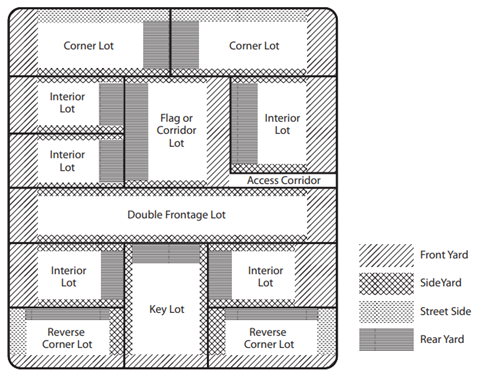
7. “Lot area” means the total horizontal area (square footage) contained within the boundaries of a lot.
a. “Gross lot area” means the lot area inclusive of streets and alleys.
b. “Net lot area” means the lot area exclusive of existing and proposed public and private streets and alleys.
8. “Lot depth” means the horizontal distance between the front and rear property lines measured along a line midway between the side property lines.
9. “Lot frontage” means that portion of a lot that abuts a street right-of-way or other principal means of access thereto.
10. “Lot width” means the horizontal distance between side lot lines, measured at the required front setback line.
11. “Low income household” means a household whose income does not exceed the lower income limits applicable to Sacramento County, as published and periodically updated by the State Department of Housing and Community Development pursuant to Section 50079.5 of the California Health and Safety Code.
12. “Luminaire” means a complete lighting unit consisting of a light source and all necessary mechanical, electrical, and decorative parts. The pole, post, or bracket is not considered a part of the luminaire.
M. “M” Definitions.
1. “Master home plan” means a home plan where the plan/home is being used multiple times within a single subdivision. Includes all variants of the same (or mirrored) floor plan where the exterior design has been altered to reflect a different architectural style but the interior floor plans are substantially the same.
2. “Maximum residential density” means the maximum number of residential units permitted by the Elk Grove General Plan land use element and Zoning Code at the time of application.
3. “Menu/order board sign” means a sign installed in a drive-through facility and oriented so as to be visible primarily by drive-through customers (see EGMC Section 23.62.110 for standards).
4. “Minimum maintained foot-candles of light” means the amount of light falling on that point of a surface with the least illumination, calculated through application of a maintenance factor, which is a multiplier applied to account for aging of the lamp and for dirt build-up on the luminaire during the period for which the lamp is in place. Unless otherwise specified, light is measured on a horizontal plane at ground level. The average maintained foot-candle of light is calculated using the industry standard uniformity ratio of average and minimum light levels of 4:1 as established by the Illuminating Engineering Society of North America.
5. “Mobile food vendor” means any vehicle, as defined in Section 670 of the California Vehicle Code, which is equipped and used for retail sales of prepared, prepackaged, or unprepared food or foodstuffs of any kind that parks at one (1) or more locations within the City. A mobile food vehicle shall also include any trailer or wagon equipped and used as described in this definition and pulled by a vehicle. Accessory retail is permitted. This definition does not include ice cream trucks. “Ice cream truck” is defined in subsection (I) of this section.
6. “Monument sign” means a freestanding sign constructed upon a solid-appearing base or pedestal.
Figure 23.100-2A
Monument Sign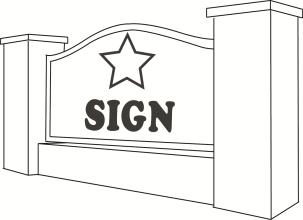
N. “N” Definitions.
1. “Name plate” means a sign attached to a wall that identifies the occupant.
2. “NEIR” means nonionizing electromagnetic radiation (e.g., electromagnetic radiation primarily in the visible, infrared, and radio frequency portions of the electromagnetic spectrum).
3. “Noncommercial messages” means visual messages on signs which pertain to or express ideas on topics of public concern. By way of example only, such messages commonly refer to debates on politics, religion, science, sports, art, history, or social issues.
4. “Noncommercial sign” means a sign which displays noncommercial speech, e.g., commentary or advocacy on topics of public debate and concern.
5. “Noncommunicative aspects” means those aspects of a sign which are not directly communicative, such as sign height, setback, illumination, spacing, density, etc.
6. “Nonconforming sign” means a sign lawfully erected and legally existing at the time of the effective date of an ordinance, but which does not conform to the provisions of this chapter.
7. “Nonhabitable structures” means buildings and/or structures of an accessory character including, but not limited to, agricultural buildings, aircraft hangars, barns, carports, fences, grain silos, greenhouses, livestock shelters, private garages, retaining walls, sheds, stables, swimming pools, tanks, towers, etc.
8. “Nontaxable merchandise” means products, commodities, or items the sale of which is not subject to California State sales tax.
9. “Nude model studio” means any place where a person: (a) appears semi-nude, in a state of nudity, or displays specified anatomical areas; and (b) is provided to be observed, sketched, drawn, painted, sculptured, photographed, or similarly depicted by other persons who pay money or any form of consideration. “Nude model studio” shall not include a proprietary school licensed by the State of California or a college, junior college or university supported entirely or in part by public taxation; a private college or university which maintains and operates educational programs in which credits are transferable to a college, junior college, or university supported entirely or partly by taxation; or in a structure:
a. That has no sign visible from the exterior of the structure and no other advertising that indicates a person in a state of nudity or a semi-nude condition is available for viewing;
b. Where, in order to participate in a class, a student must enroll at least three (3) days in advance of the class; and
c. Where no more than one (1) nude or semi-nude model is on the premises at any one (1) time.
10. “Nudity” or “a state of nudity” means the showing of the human male or female genitals, pubic area, anus, or buttocks with less than a fully opaque fabric covering, the showing of the female breast with less than a fully opaque fabric covering of any part of the areola, except as allowed for the purpose of breast feeding, or the showing of completely or opaquely covered (by fabric) male genitals in a discernibly turgid state.
O. “O” Definitions.
1. “Off-site or off-premises sign” means a sign that identifies, advertises or attracts attention to a business, product, service, event or activity sold, existing or offered at a different location (subject to the qualifications stated in the definition of “on-site or on-premises sign”). The off-site/on-site distinction applies only to commercial messages.
2. “One hundred (100) year floodplain” means areas that have a one (1) in one hundred (100) chance of flooding in any given year using criteria consistent with, or developed by, the Federal Emergency Management Agency (FEMA). Areas within the one hundred (100) year floodplain are identified in Flood Insurance Rate Maps (FIRM) maintained by FEMA.
3. “On-site or on-premises sign” means any sign that identifies, advertises, or attracts attention to a business, product, service, event or activity sold, existing or offered upon the same property or land use as the sign. The off-site/on-site distinction applies only to commercial messages. In the case of multiple-tenant commercial or industrial developments, a sign is considered “on-site” whenever it is located anywhere within the development. In the case of a duly approved uniform sign program or special planning area, a sign anywhere within the area controlled by the program or SPA may be considered “on-site” when placed at any location within the area controlled by the program or SPA.
4. “Open view fencing” means fencing that is substantially open to light and air passage such that more than fifty (50%) percent of the fence surface area is open. Examples include, but are not limited to, split rail and ornamental tubular steel.
P. “P” Definitions.
1. “Pad building” means a building with either a single or multiple tenants that is (see Figure 23.100-3):
a. Separated from other buildings by surface parking and/or a public right-of-way on at least two (2) sides without an anchor tenant (gross floor area > fifty (50 ft2) square feet; or
b. A stand-alone building with a drive-through.
Figure 23.100-3
Pad Buildings vs. In-Line Shops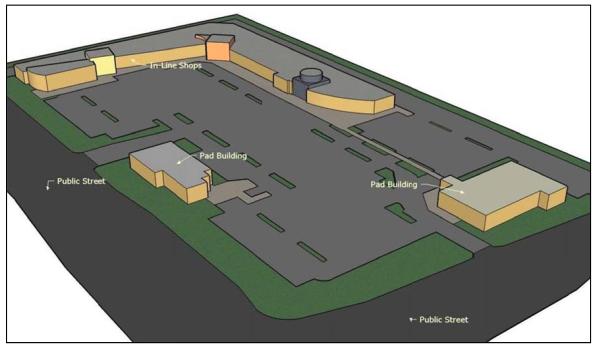
2. “Pending application” means any formal application submitted to the City for a land use or development permit or action that has been deemed complete, but has not yet been acted upon/finally decided by the designated approving authority, including any appeal determination.
3. “Pennant” means any lightweight plastic, fabric, or other material, whether or not containing a message of any kind, attached to a rope, wire, or string, usually in a series, designed to move in the wind and attract attention.
4. “Persons and families of moderate income” means households whose income does not exceed the moderate limits applicable to Sacramento County, as published and periodically updated by the State Department of Housing and Community Development pursuant to Section 50093 of the California Health and Safety Code.
5. “Pole sign” means a freestanding sign supported by one (1) or more metal or wood posts, pipes, or other vertical supports.
6. “Portable sign” means any sign not permanently attached to the ground or other permanent structure, or a sign designed to be transported. Portable signs include, but are not limited to, signs designed to be transported by means of wheels; signs configured as A-frame or T-frame; menu and sandwich board signs; and umbrellas used for advertising. Clothing or other aspects of personal appearance are not within this definition (see definition of “commercial mascot”).
7. “Primary dwelling unit” means an existing single-family residential structure on a single parcel with provisions for living, sleeping, eating, a single kitchen for cooking as defined in this chapter, and sanitation facilities occupied and intended for one (1) household.
8. “Project” means proposed development or a new land use.
9. “Property line, front” means that narrowest property line which abuts a public street (see Figure 23.100-4A). In the case of a flag lot, it shall be property line that abuts the access corridor (see Figure 23.100-4B). In the case of lots along cul-de-sacs, elbows, or other similar roadways where the property does not comply with the minimum frontage requirements of this title, the front property line for purposes of determining setbacks shall be measured from an imaginary line drawn parallel to the property line along the street and with a minimum length equal to the minimum frontage (see Figure 23.100-4C).
10. “Property line, rear” means the property line which is opposite and most distant from the front property line and most parallel to the front property line. See Figures 23.100-4A, 4B, and 4C for an example of a common rear property line and see Figure 23.100-4D for an example of a rear property line on an irregular shaped lot where the rear property line is not exactly parallel to the front property line. In the case of lots where the side property lines converge to a point, the rear property line for purposes of determining rear setbacks shall be measured from an imaginary line drawn parallel to the front property line and with a minimum length of ten (10' 0") feet. See Figure 23.100-4E for an example.
11. “Property line, side” means those property lines that are not the front or rear property lines.
12. “Property line, street side” means a side property line that abuts a public street.
Figure 23.100-4A
Property Lines – Interior and Corner Lots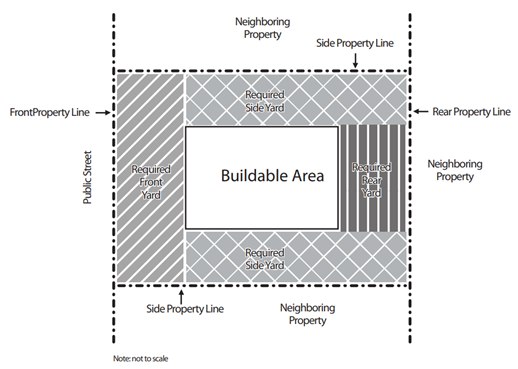

Figure 23.100-4B
Property Lines – Flag Lots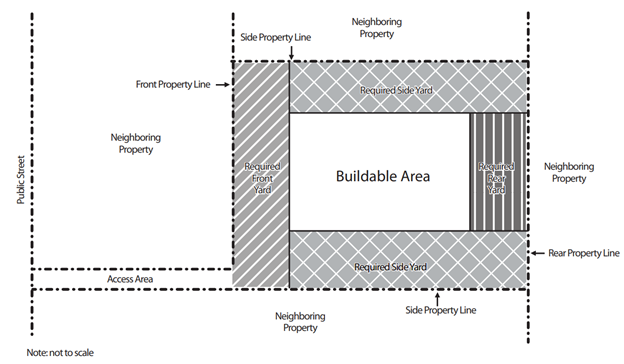
Figure 23.100-4C
Property Lines (lots along cul-de-sacs, elbows, or other similar roadways)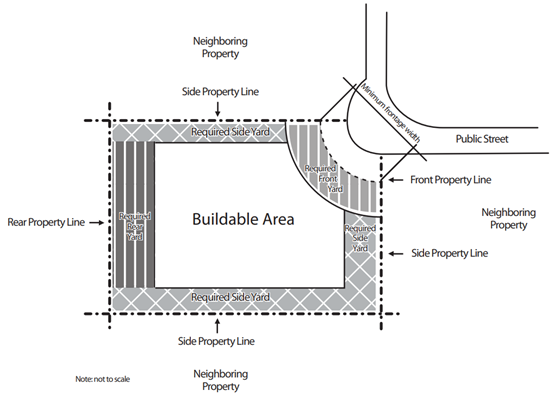
Figure 23.100-4D
Property Lines – Irregular Lots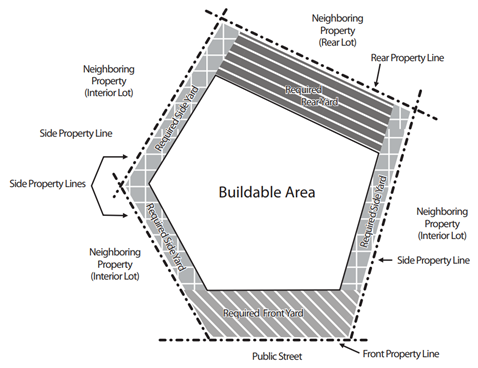
Figure 23.100-4E
Property Lines – Converging Lot Lines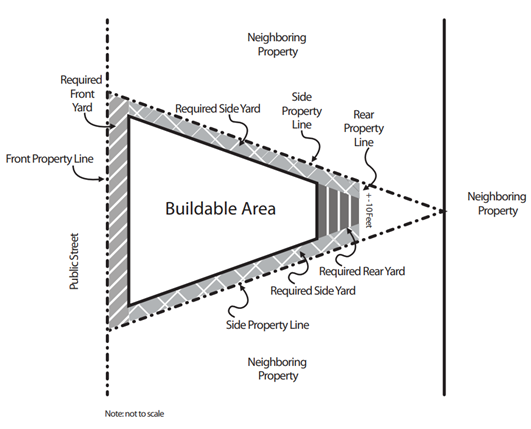
13. “Private residential recreation facility” means a privately owned, noncommercial outdoor recreation facility which does not require dues or payment for admission, such as a soccer field, softball or baseball field, tennis court, or basketball court, accessory to the primary residential use of the property.
14. “Public nuisance” means anything which is injurious to health, including, but not limited to, the illegal sale of controlled substances, or is indecent or offensive to the senses, or an obstruction to the free use of property, so as to interfere with the comfortable enjoyment of life or property, or unlawfully obstructs the free passage or use, in the customary manner, of any navigable lake, or river, bay, stream, canal, or basin, or any public park, square, street, or highway. A public nuisance is one which affects at the same time an entire community or neighborhood, or any considerable number of persons, although the extent of the annoyance or damage inflicted upon individuals may be unequal.
15. “Pylon sign” means a freestanding sign that is supported by one (1) or more structural elements that are architecturally similar to the design of the sign.
Figure 23.100-4F
Pylon Sign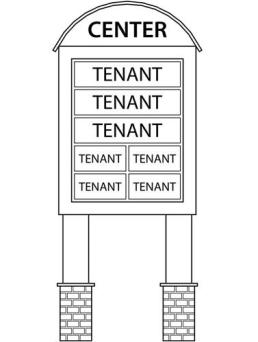
Q. Reserved for future use.
R. “R” Definitions.
1. “Readerboard sign” means a sign on which copy is changed manually in the field or electronically, including but not limited to theater marquee signs, business directories, church and museum signs, and gas price signs.
2. “Real estate sign” means any sign, temporary in nature, the copy of which concerns a proposed economic transaction involving real property. This definition does not include occupancy signs at establishments offering transient occupancy, such as hotels and motels.
3. “Recommending authority” means an official or body of the City’s Planning Agency (e.g., Planning Commission, Zoning Administrator, Development Services Director), as defined in EGMC Section 23.10.020, who is to make a recommendation to the designated approving authority on an action regarding a planning permit, entitlement, or legislative action.
4. “Recreational vehicle (RV)” means any motor home, travel trailer, truck camper, camper trailer, all terrain vehicle (ATV), or similar vehicle.
5. “Related equipment” in the context of wireless facilities means all equipment ancillary to the transmission and reception of voice and data by means of radio frequencies. Such equipment may include cable, conduit, connectors, equipment pads, equipment shelters, cabinets, buildings, and access ladders.
6. “Retaining wall” means a wall constructed as part of the development of the site through the issuance of a grading permit or as part of a roadway improvement project that is designed and engineered to retain soil for purposes of soil stabilization.
7. “Right-of-way line” means the dividing line between a street (including curb, gutter, sidewalk, and other associated infrastructure) and the abutting property.
8. “Roof sign” means a sign installed on a roof or projecting above the eve of a building or mounted on an arcade or parapet.
9. “Roofline” means the top edge of a roof or building parapet, whichever is higher, excluding any cupolas, pylons, chimneys, or minor projections.
S. “S” Definitions.
1. “Sales floor area” means all interior building space including, but not limited to, storage space, automobile service areas, or open-air garden sales space.
2. “Satellite earth station” means a facility consisting of more than a single satellite dish or parabolic antenna that transmits to and/or receives signals from an orbiting satellite.
3. “Semi-nude” or “in a semi-nude condition” means a state of dress in which clothing covers no more than the genitals, pubic region, buttocks and areola of the female breast as well as portions of the body covered by supporting straps or devices.
4. “Senior citizen housing development” means a residential development developed, substantially rehabilitated, or substantially renovated for senior citizens that has at least thirty-five (35) dwelling units and complies with the requirements of Section 51.3 of the California Civil Code.
5. “Setback” means the minimum distance between the main building and property lines of the lot, measured at a right angle from the designated property line. Minimum setback distances are listed by zoning district in Division III, Zoning Districts, Allowable Uses, and Development Standards, of this title. See Figure 23.64-3.
6. “Sexual encounter center” means a business or commercial enterprise that, as one (1) of its principal purposes, offers for any form of consideration physical contact in the form of wrestling or tumbling between persons of the opposite sex, when one (1) or more of the persons is in a state of nudity or semi-nude condition. The definition of sexual encounter center does not include an establishment where a medical practitioner, physiologist, psychiatrist, or similar professional person licensed by the State engages in medically approved and recognized sexual therapy.
7. “Sexually oriented business” means an adult-oriented business.
8. “Shielding” means a technique or method of construction which causes light emitted from an outdoor light fixture to be projected below an imaginary horizontal plane passing through the fixtures.
9. Short-Term Bicycle Parking. Short-term bicycle parking facilities typically consist of bike racks where cyclists can park their bike for several hours or less and are targeted to visitors, customers and other short-term users.
10. “Sign” means any device, structure, fixture, or placard displaying graphics, symbols, and/or written copy for the primary purpose of communicating with the public, when such image is visible from any public right-of-way. Notwithstanding the generality of the foregoing, the following are not within this definition:
a. Architectural Features. Decorative or architectural features of buildings (not including lettering, trademarks or moving parts);
b. Fireworks, Etc. The legal use of fireworks, candles and artificial lighting not otherwise regulated by this chapter;
c. Graphic images which are visible only from above, such as those visible only from airplanes or helicopters, only if not visible from the street surface or public right-of-way;
d. Gravestones and grave markers;
e. Interior Signs. Signs or other visual communicative devices that are located entirely within a building or other enclosed structure and are not visible from the exterior thereof, or located at least five (5' 0") feet from the window, provided the building or enclosed structure is otherwise legal;
f. Manufacturers’ Marks. Marks on tangible products which identify the maker, seller, provider or product, and which customarily remain attached to the product even after sale;
g. Mass Transit Graphics. Graphic images mounted on trains or duly licensed mass transit vehicles that legally pass through the City;
h. Newsracks and newsstands;
i. On residential uses, holiday and cultural observance decorations which are on display for not more than forty-five (45) calendar days per year (cumulative, per parcel or use) and which do not include commercial advertising messages;
j. Personal Appearance. Items or devices of personal apparel, decoration or appearance, including tattoos, makeup, wigs, costumes, masks, etc. (but not including commercial mascots);
k. Shopping carts, golf carts, and horse-drawn carriages;
l. Symbols Embedded in Architecture. Symbols of noncommercial organizations or concepts including, but not limited to, religious or political symbols, when such are permanently integrated into the structure of a permanent building which is otherwise legal; the definition also includes foundation stones and cornerstones;
m. Vehicle and Vessel Insignia. On street-legal vehicles and properly licensed watercraft: license plates, license plate frames, registration insignia, noncommercial messages, messages relating to the business of which the vehicle or vessel is an instrument or tool (not including general advertising) and messages relating to the proposed sale, lease or exchange of the vehicle or vessel;
n. Vending machines which do not display off-site commercial messages or general advertising messages.
11. “Specified anatomical areas” means and includes the following:
a. Less than completely and opaquely covered by fabric: (i) human genitals or pubic region; (ii) human buttocks; (iii) human anus; or (iv) the female breast below a point immediately above the top of the areola;
b. Human male genitals in a discernibly turgid state, even if completely or opaquely covered by fabric; and
c. Any device, costume, or covering that simulates any of the body parts included in subsection (a) or (b) of this definition.
12. “Specified sexual activities” means and includes any of the following, whether performed directly or indirectly through clothing or other covering:
a. The fondling or other erotic touching of human genitals, pubic area, buttocks, anus, or female breast;
b. Sex acts, actual or simulated, including, but not limited to, intercourse, oral copulation, or sodomy;
c. Masturbation, actual or simulated;
d. Excretory functions as part of or in connection with any of the other activities described in subsections (a) and (b) of this definition.
13. “Structure” means anything constructed or erected, the use of which requires attachment to the ground or attachment to something located on the ground. For the purpose of this Zoning Code, the term “structure” includes buildings.
14. “Subdivision sign” means a temporary or limited-term sign, erected with the intent of identifying and directing vehicular and/or pedestrian traffic to the initial home sales of multiple lots with a single builder within a master planned community, including both single-family and multifamily for-sale products. All other home sales are included within the definition of real estate signs. This excludes entry monument signs for single-family subdivisions which are permanent signs designed to identify a master planned community.
T. “T” Definitions.
1. “Target unit” means a dwelling unit within a housing development which will be reserved for sale or rent to, and affordable to, very low or lower income households, or qualifying residents.
2. “Temporary real estate” means the temporary use of a dwelling unit within a residential development project as a sales office for the units on the same site, which is converted to residential use at the conclusion of its office use.
3. “Temporary sign” means a sign not constructed or intended for long-term use. Typically, temporary signs are not physically suitable for display longer than thirty (30) days. If a sign does not qualify as a “structure” under the building code, it is presumably a temporary sign, but subject to the interpretation of the Development Services Director under EGMC Section 23.62.050(B), Regulatory Interpretations.
4. “Time/temperature sign” means an electronic or mechanical device that shows time and/or temperature but contains no business identification or advertising.
5. “Tower” means a mast, pole, monopole, lattice tower, or other structure designed and primarily used to support antennas. This definition includes ground-mounted structures twelve (12' 0") feet or greater in height and building-mounted structures that extend above the roofline, parapet wall, or other roof screen with a mast greater than six (6") inches in diameter supporting one (1) or more antennas, dishes, arrays, or other associated equipment.
6. “Traditional public forum” means the surfaces of City-owned streets, public parks, sidewalks which are connected to the City’s main pedestrian circulation system, and the pedestrian area immediately surrounding City Hall (not including the interior thereof). In consultation with the City Attorney, the Development Services Director shall interpret this phrase in light of relevant court decisions.
7. “Trailer” means a vehicle designed to be towed by a motor vehicle that is used solely for the transportation of personal property, not for commercial purposes, which does not exceed a gross weight of ten thousand (10,000 lbs) pounds. This definition includes vessel trailers, utility trailers, flat bed trailers, box trailers, horse trailers, or similar vehicle.
8. “Two hundred (200) year floodplain” means areas that have a one (1) in two hundred (200) chance of flooding in any given year using criteria consistent with, or developed by, the Department of Water Resources. As used in this chapter, the term shall be ascribed to all areas labeled as such in the General Plan.
U. “U” Definitions.
1. “Under-Canopy Sign.” See “blade/bracket sign.”
2. “Urban level of flood protection” means the level of protection that is necessary to withstand flooding that has a one (1) in two hundred (200) chance of occurring in any given year using criteria consistent with, or developed by, the Department of Water Resources.
V. “V” Definitions.
1. “Vehicle sign” means a sign that is attached to and is an integral part of a motorized vehicle or bicycle used directly for the purpose of a particular business and not used primarily as a sign base or for general advertising.
2. “Very low income household” means a household whose income does not exceed the very low income limits applicable to Sacramento County, as published and periodically updated by the State Department of Housing and Community Development pursuant to Section 50105 of the California Health and Safety Code.
3. “Vessel” means any sail-powered or motor-driven vehicle that is used on the water. This includes motorboats, amphibious vehicle/vessels, and inflatable vessels with motors, shuttlecraft, jet skis or wet bikes, or similar vehicle.
W. “W” Definitions.
1. “Wall sign” means a sign attached directly to an exterior wall of a building or dependent upon a building for support with the exposed face of the sign located in such a way as to be substantially parallel to such exterior building wall to which it is attached or by which it is supported.
2. “Window sign” means a sign attached to, suspended behind, placed, or painted upon the window or glass door of a building and intended for viewing from the exterior of such building. This definition does not include merchandise offered for sale on site, when on display in a window.
X. Reserved for future use.
Y. “Y” Definitions.
1. “Yard” means land unoccupied or unobstructed, except for such encroachments as may be permitted by this title, surrounding a building site. Types of yards include the following and are illustrated in Figures 23.100-2, 23.100-4A, 23.100-4B, 23.100-4C, 23.100-4D, and 23.100-4E. The term “yard” may be utilized to apply to the required yard as determined through application of a setback from the corresponding property line (as in a “front yard setback”) or to the actual yard area between a property line and a structure (as in the actual front yard area).
a. “Yard, front” means a yard extending across the full width of the lot along the front property line.
b. “Yard, rear” means a yard extending across the width of the property along the rear property line. A rear yard shall not extend past the interior limits of a side yard or side street yard.
c. “Yard, side” means a yard extending along an interior side property line from the front yard to the rear property line.
d. “Yard, side street” means a yard extending along a side lot line adjacent to the street right-of-way, extending from the front yard to the rear property line.
2. “Yard (area), required” means the horizontal area between a property line and a parallel line drawn at the minimum (primary structure) setback distance, measured at a right angle from the property line. See Figure 23.100.5.
3. “Yard (area), actual” means the horizontal area between a property line and a parallel line along the nearest structure located outside of the required setback area. See Figure 23.100.5.
Figure 23.100.5
Required vs. Actual Yard Area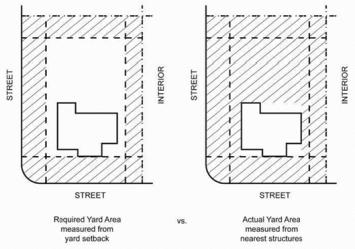
Z. Reserved for future use. [Ord. 11-2024 §3 (Exh. A), eff. 10-11-2024; Ord. 34-2022 §3 (Exh. A), eff. 2-10-2023; Ord. 16-2021 §4 (Exh. B), eff. 9-10-2021; Ord. 29-2019 §3 (Exh. A), eff. 2-7-2020; Ord. 28-2019 §3 (Exh. A), eff. 2-7-2020; Ord. 6-2019 §3 (Exh. A), eff. 4-26-2019; Ord. 14-2017 §3 (Exh. C), eff. 6-23-2017; Ord. 15-2016 §3 (Exh. A), eff. 9-23-2016; Ord. 24-2015 §11 (Exh. I), eff. 2-12-2016; Ord. 23-2014 §3 (Exh. A), eff. 10-10-2014; Ord. 15-2014 §3 (Exh. A), eff. 8-22-2014; Ord. 4-2014 §3 (Exh. B), eff. 3-28-2014; Ord. 13-2013 §7, eff. 10-25-2013; Ord. 1-2013 §4, eff. 3-15-2013; Ord. 19-2012 §5, eff. 11-9-2012; Ord. 18-2012 §7, eff. 10-12-2012; Ord. 8-2011 §41, eff. 6-24-2011]


